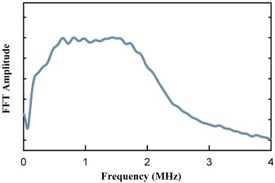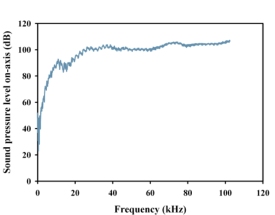home
> products
> BAT's
> BAT
performance > frequency responses
Typical frequency responses of BAT® transducers
at high-frequencies ( f >100kHz ):
MicroAcoustic's
BAT®
transducers have been designed primarily for broadband ultrasonic use in
gases, where the typical bandwidth of a single BAT®
extends from 40kHz to ~2MHz.
Because most ultrasonic applications in atmospheric air are naturally limited to
frequencies below ~2MHz (due to excessively high attenuation in air
at higher frequencies), a single BAT®
operates over the entire practical frequency range for air-coupled
ultrasound. This means you do not need to purchase a different
transducer for each frequency range of interest (as with other
air-transducers); instead, you can simply alter your applied drive
waveforms and watch the output pressure wave from the BAT®
change to whatever you desire. Such wideband behaviour further allows for effective deployment of a wide range of advanced
signal-processing techniques, all of which improve in their performance
with increasing bandwidth. 
Shown at right is a typical high-frequency response curve for a BAT® receiver in air: The receiver studied was MicroAcoustic's unfocussed BAT-1 transducer having a 10mm diameter planar aperture. Because BAT® transducers are reciprocal, the shape of this sensitivity curve applies equally well to generation when the same transducer is used alternatively as a source. [Note that the fall-off below 100kHz in this figure is due mostly to the receive electronics used here and not the transducer; a better indication of the low-frequency BAT® performance is included below.]
Though designed
primarily for high frequency ultrasonic use, BAT®
transducers are also very useful for generating and receiving acoustic
waves in gases at frequencies below 100kHz. BAT®
detectors even double
as excellent microphones right down into the audio band. 
Shown
at right is a typical low-frequency response curve for a BAT®
source in air: This
curve was obtained using a calibrated high-frequency microphone placed on
axis of the source. The source studied was MicroAcoustic's
unfocussed BAT-1 transducer
having a 10mm diameter planar aperture. Because
BAT® transducers are known to be reciprocal, the shape
of this sensitivity curve applies equally well to detection at frequencies
below 100kHz.
www.microacoustic.com